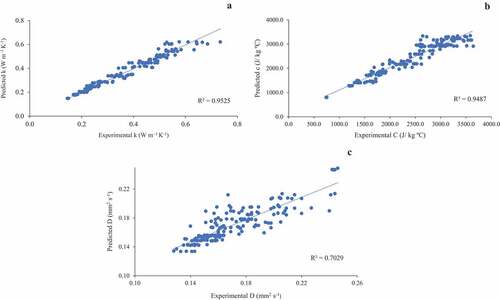Figures & data
Table 1. Thermophysical properties calculated using Choi and Okos' (1986) model based on the proximate content of food
Table 2. Thermal conductivity of sugar kelp measured using KD2 Pro and Choi and Okos' model
Table 3. Thermophysical properties (k, D, and C) of terrestrially grown foods
Table 4. Specific heat capacity of sugar kelp measured using KD2 Pro and Choi and Okos' model
Table 5. Thermal diffusivity of sugar kelp measured using KD2 Pro and Choi and Okos' model
Table 6. Measured Bulk density, calculated porosity and the Choi and Okos' model porosity of sugar kelp
Table 7. Prediction errors in the thermophysical properties with different ANN configurations and Choi and Okos' Model
Table 8. Regression parameters for predicting the thermophysical properties of sugar kelp with the best ANN configuration
Figure 1. Correlation of experimental versus neutral network values of thermophysical properties of sugar kelp with training data set (a) thermal conductivity, (b) specific heat capacity, (c) thermal diffusivity. The best ANN configuration included 8, 10, and 14 neurons in each layer for (a) thermal conductivity, (b) specific heat capacity, (c) thermal diffusivity, respectively

